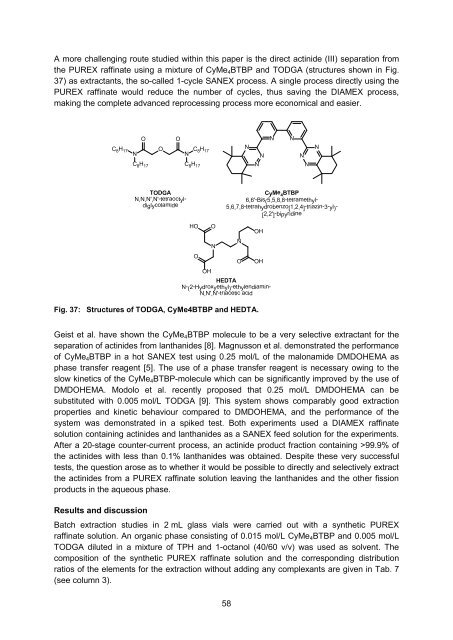Annual Report 2009/2010 - JUWEL - Forschungszentrum Jülich
Annual Report 2009/2010 - JUWEL - Forschungszentrum Jülich
Annual Report 2009/2010 - JUWEL - Forschungszentrum Jülich
Create successful ePaper yourself
Turn your PDF publications into a flip-book with our unique Google optimized e-Paper software.
A more challenging route studied within this paper is the direct actinide (III) separation from<br />
the PUREX raffinate using a mixture of CyMe 4 BTBP and TODGA (structures shown in Fig.<br />
37) as extractants, the so-called 1-cycle SANEX process. A single process directly using the<br />
PUREX raffinate would reduce the number of cycles, thus saving the DIAMEX process,<br />
making the complete advanced reprocessing process more economical and easier.<br />
O<br />
O<br />
C 8 H 17 N<br />
O<br />
N C 8 H 17<br />
C 8 H 17 C 8 H 17<br />
N<br />
N<br />
N<br />
N<br />
N<br />
N<br />
N<br />
N<br />
TODGA<br />
N,N,N',N'-tetraoctyldiglycolamide<br />
Fig. 37: Structures of TODGA, CyMe4BTBP and HEDTA.<br />
CyMe 4 BTBP<br />
6,6'-Bis ( 5,5,8,8-tetramethyl-<br />
5,6,7,8-tetrahydrobenzo [ 1,2,4] -triazin-3- yl) -<br />
[2,2'] -bipy ridine<br />
HO O<br />
OH<br />
N<br />
N<br />
O<br />
O OH<br />
OH<br />
HEDTA<br />
N- ( 2-Hydroxyethyl) -ethylendiamin-<br />
N,N',N'-triacetic acid<br />
Geist et al. have shown the CyMe 4 BTBP molecule to be a very selective extractant for the<br />
separation of actinides from lanthanides [8]. Magnusson et al. demonstrated the performance<br />
of CyMe 4 BTBP in a hot SANEX test using 0.25 mol/L of the malonamide DMDOHEMA as<br />
phase transfer reagent [5]. The use of a phase transfer reagent is necessary owing to the<br />
slow kinetics of the CyMe 4 BTBP-molecule which can be significantly improved by the use of<br />
DMDOHEMA. Modolo et al. recently proposed that 0.25 mol/L DMDOHEMA can be<br />
substituted with 0.005 mol/L TODGA [9]. This system shows comparably good extraction<br />
properties and kinetic behaviour compared to DMDOHEMA, and the performance of the<br />
system was demonstrated in a spiked test. Both experiments used a DIAMEX raffinate<br />
solution containing actinides and lanthanides as a SANEX feed solution for the experiments.<br />
After a 20-stage counter-current process, an actinide product fraction containing >99.9% of<br />
the actinides with less than 0.1% lanthanides was obtained. Despite these very successful<br />
tests, the question arose as to whether it would be possible to directly and selectively extract<br />
the actinides from a PUREX raffinate solution leaving the lanthanides and the other fission<br />
products in the aqueous phase.<br />
Results and discussion<br />
Batch extraction studies in 2 mL glass vials were carried out with a synthetic PUREX<br />
raffinate solution. An organic phase consisting of 0.015 mol/L CyMe 4 BTBP and 0.005 mol/L<br />
TODGA diluted in a mixture of TPH and 1-octanol (40/60 v/v) was used as solvent. The<br />
composition of the synthetic PUREX raffinate solution and the corresponding distribution<br />
ratios of the elements for the extraction without adding any complexants are given in Tab. 7<br />
(see column 3).<br />
58
















